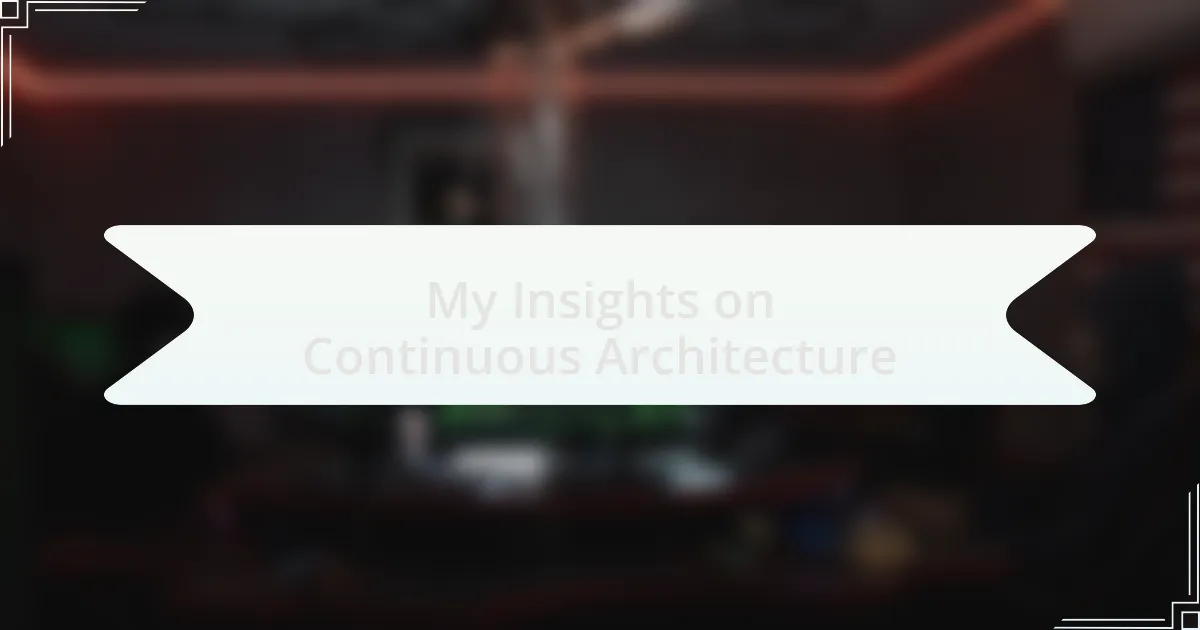Key takeaways:
- Continuous Architecture allows software teams to adapt designs iteratively based on real-time feedback, fostering innovation and shared ownership.
- It enhances collaboration across disciplines, leading to more cohesive architectural decisions and quick identification of potential issues.
- Implementing Continuous Architecture faces challenges like managing legacy systems, maintaining communication, and fostering a collaborative culture.
Author: Oliver Bennett
Bio: Oliver Bennett is an acclaimed author known for his gripping thrillers and thought-provoking literary fiction. With a background in journalism, he weaves intricate plots that delve into the complexities of human nature and societal issues. His work has been featured in numerous literary publications, earning him a loyal readership and multiple awards. Oliver resides in Portland, Oregon, where he draws inspiration from the vibrant local culture and stunning landscapes. In addition to writing, he enjoys hiking, cooking, and exploring the art scene.
Definition of Continuous Architecture
Continuous Architecture is an evolving approach in software development that enables teams to adapt and respond to changes more fluidly. It emphasizes the importance of an iterative and collaborative process, allowing for constant adjustments based on real-time feedback and emerging requirements. Have you ever felt that dread of locking down a design only to find out it’s already outdated? Continuous Architecture remedies that frustration by integrating architecture into the daily workflow.
In my own experience, embracing Continuous Architecture has been liberating. I remember a project where the initial architecture felt too rigid, almost like a straitjacket. Once we shifted to a continuous mindset, we found ourselves innovating rather than just executing. This approach not only fosters creativity but also cultivates a culture of shared ownership among team members, leading to more robust and informed architectural decisions.
At its core, Continuous Architecture is about keeping pace with change. Imagine being able to pivot your architecture as quickly as the market demands, ensuring your software is always relevant and competitive. It’s a powerful shift, one that encourages us to embrace uncertainty and view challenges as opportunities for growth instead of obstacles. What could this mean for your own projects?
Importance of Continuous Architecture
Continuous Architecture plays a vital role in keeping software projects aligned with evolving business goals. I recall a time when the market dynamics shifted overnight, leaving our traditional architecture in the dust. If we hadn’t embraced a continuous approach, adapting to new customer demands would have been an uphill battle, potentially jeopardizing our competition.
Moreover, the value of Continuous Architecture lies in its ability to enhance collaboration among teams. When I facilitated cross-functional meetings, I witnessed firsthand how sharing insights from design, development, and testing led to more cohesive architectural decisions. Have you ever seen teams come together and ignite creativity simply by exchanging ideas? This synergy is a direct result of the iterative nature of Continuous Architecture, allowing diverse perspectives to find their way into the final product.
Another critical aspect is the early identification of architectural issues, which can save significant time and resources down the line. I distinctly remember a project where we identified potential bottlenecks during our frequent reviews, enabling us to address them proactively. Isn’t it remarkable how a continuous process can transform our perception of risk from something daunting into an opportunity for early intervention? This mindset shift is not just beneficial; it’s essential for achieving longevity in today’s fast-paced software landscape.
Key Principles of Continuous Architecture
One key principle of Continuous Architecture is iterative design. I remember when my team shifted from a waterfall approach to iterative cycles. Each iteration allowed us to refine our architectural decisions based on real user feedback, which not only improved the product but also boosted our team’s morale. Have you ever witnessed how small, consistent improvements can lead to significant breakthroughs over time? That’s the essence of continuous evolution in architecture.
Collaboration across disciplines is another cornerstone. I often think back to a project where developers, testers, and business analysts huddled together to brainstorm architectural solutions. The result was a rich tapestry of ideas that surpassed any single perspective. It makes me wonder: how often do we miss out on innovation simply because we don’t involve all relevant voices in our discussions?
Lastly, embracing change is crucial. I cannot stress enough how difficult it was initially for my team to adapt to constant modifications in our architecture. However, when we learned to welcome change, it transformed our workflow. Isn’t it fascinating how, through trust in our processes, we turned the fear of instability into a driving force for creativity? This ongoing adaptation is what keeps architectures robust and ready for future challenges.
Challenges in Implementing Continuous Architecture
Implementing Continuous Architecture often confronts teams with the challenge of managing legacy systems. I recall a project where integrating new architectural principles into an outdated codebase felt like trying to fit a square peg into a round hole. As we worked to adapt modern practices, the anxiety of breaking existing functionality loomed large. It’s a tough reminder that innovation can sometimes feel like a delicate dance with the past.
Another significant hurdle is maintaining consistent communication among team members. I’ve experienced instances where misalignment between developers and stakeholders led to architectural misunderstandings, which delayed our progress and caused frustration. It makes me think, how often do we assume everyone is on the same page when, in reality, we’re speaking different languages? This underlines the importance of creating structured channels for ongoing dialogue.
Finally, the cultural shift required for Continuous Architecture can be daunting. I’ve seen teams struggling to relinquish control in favor of collaborative decision-making. There’s a palpable tension when team members fear losing their individual influence. It raises an important question: how do we create an environment where everyone feels empowered to contribute without fear? Embracing this cultural evolution is essential, but it requires time and persistent effort.

Leave a Reply